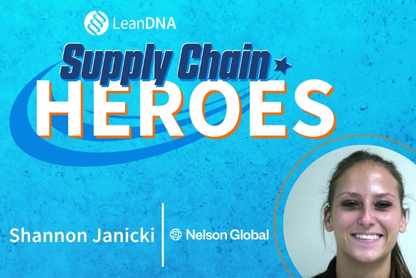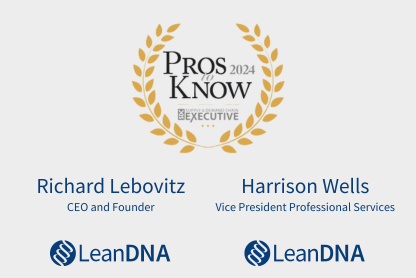To an outsider, the lean manufacturing world can look a little like alphabet soup. Within five minutes of any lean meeting, you will hear acronyms that can seem like the letters are strung together with no rhyme or reason.
But as you and your company embrace lean, those letters start to work like alphabet magnets on a refrigerator. They are purposefully arranged to form acronyms and concepts that separate lean from, well, not-lean. (Side note: “not-lean” is probably not a term real Lean pros would use.)
Let’s take a look at the following 26 terms to better understand what makes lean manufacturing effective. And who knows, we might just learn a term for “not-lean.”
A3
A method of problem solving in which all important information about the problem fits on one piece of 11” x 17” paper. The goal is to create one document that is small enough to be easily carried around or displayed, but large enough to hold all the data you need to tell the complete story. Sometimes called the A3 report.
ABC Analysis
The process of ordering parts by value sold. This allows you to determine which parts have the highest volume. Typically, 80% of your units or sales will be represented by 20% of your parts – these are your A items. B items would generally be the next 15% of units or sales, and C parts would be the remaining 5%.
Cycle Time
The time it takes to complete one particular task from start to finish. The goal is to improve your cycle time so that it becomes the fastest repeatable time to complete a given process.
Dashboard
If you are a pilot, this is your cockpit. For LeanDNA users, this is the first page you visit every morning and it directs your work day. It displays all the important data and links to corresponding charts and reports.
DMAIC
A structured problem-solving methodology that features the following steps: Define, Measure, Analyze, Improve, and Control.
ERP (Enterprise Resource Planning)
The business management software that controls many aspects of your business. This includes production, shipping, receiving, etc. LeanDNA has the ability to sync with your system to provide a window into the multitude of data contained in your ERP.
Gantt Chart
A bar chart displaying your project schedule. Created by Henry Gantt, this is used to show your current schedule status and how that compares to what was planned.
JIT (Just-in-Time)
A system in which material is received at the exact time when it is needed. This creates an optimal material flow, never leaving you with too many or too few parts.
Kaizen
A Japanese word that roughly translates to “continual improvement.” Kaizen aims to eliminate waste to change processes for the better.
Kanban
An inventory-control tool that is one of the primary tools in a JIT (Just-in-Time) system. It allows for the entire manufacturing process to have an efficient flow of materials, while keeping WIP and inventory low.
KPI (Key Performance Indicator)
A performance measurement used to evaluate the success of a business or system. KPIs are the things you consider to be most important to track. In LeanDNA, this information is tracked via the Dashboard.
Lead Time
The amount of time it takes from the time you place an order to when you will receive that order. This includes production time, processing, shipping, and all other aspects that take place prior to receiving your order. Lead time must be considered when placing orders with your suppliers. If a part has a 100-day lead time, you cannot expect to receive that part in less than 100 days.
Lean
This list wouldn’t be complete without defining lean itself! The term comes from the Toyota Production System who define themselves as, “a production system which is steeped in the philosophy of ‘the complete elimination of all waste.’"
MRP (Material requirements planning)
A way of keeping track of mass data by using production planning and scheduling software.
Muda
Japanese term for "waste." This is probably the closest thing to “not-lean.” Eliminating muda from your business processes brings you closer to true lean manufacturing success.
Pareto Analysis
Often referred to as the 80/20 rule. This manner of ordering data by quantity helps you understand how 80% of your units or sales will be represented by 20% of your parts. Named after Italian economist Vilfredo Pareto.
PDCA
A structured problem-solving methodology that features the following steps: Plan, Do, Check, Act. Popularized by Dr. W. Edwards Deming.
PFEP
Plan For Every Part. Defines and maintains information about every part used in your manufacturing process: where it comes from; how it’s purchased and received; its weight and dimensions; and how it’s packaged, stored and delivered.
Pull In
The process of bringing in inventory ahead of the original schedule. This is used to prevent shortages or replace scrapped material.
Push Out
The opposite of Pull in. Used to postpone the receipt of material. This can because of a schedule change or a slowdown. Push outs prevent you from holding too much inventory at one time.
RCA (Root Cause Analysis)
A problem-solving method in which the ultimate cause of a problem is determined above all else. This allows a team to understand what exactly is going wrong in the lean manufacturing process so they can do more than fix the symptoms.
SMED (Single Minute Exchange of Die)
A method used to reduce waste in a manufacturing process. The goal is to streamline changeover to shorten the time it takes from running the current product to running the next product.
Standard Work
A document used to prioritize daily, weekly and monthly activities. This is used to standardize workflow so that all team members know which tasks are the highest priority. An important way to make lean stick.
Value Stream
The sequence of work needed to turn a raw material into a finished product. Improving this process increases the value of the good.
VMI (Vendor Managed Inventory)
An approach to inventory management that features collaboration between supplier and customer. The supplier receives data showing the customer’s real-time inventory levels. It is up to the supplier to replenish that material as needed to stay between set goal posts for prearranged inventory levels.
X Matrix
A matrix that shows objectives, tasks and other action items used within projects. This ensures complete ownership of the projects and allows you to implement plans that are coordinated across the lean factory.
WIP (Work in Process)
Partially finished goods waiting for completion.
You're on your way to lean manufacturing expertise
There can be a lot to digest at first, but the meanings of each of these terms and lean manufacturing as a whole can significantly improve your lean factory's success.







